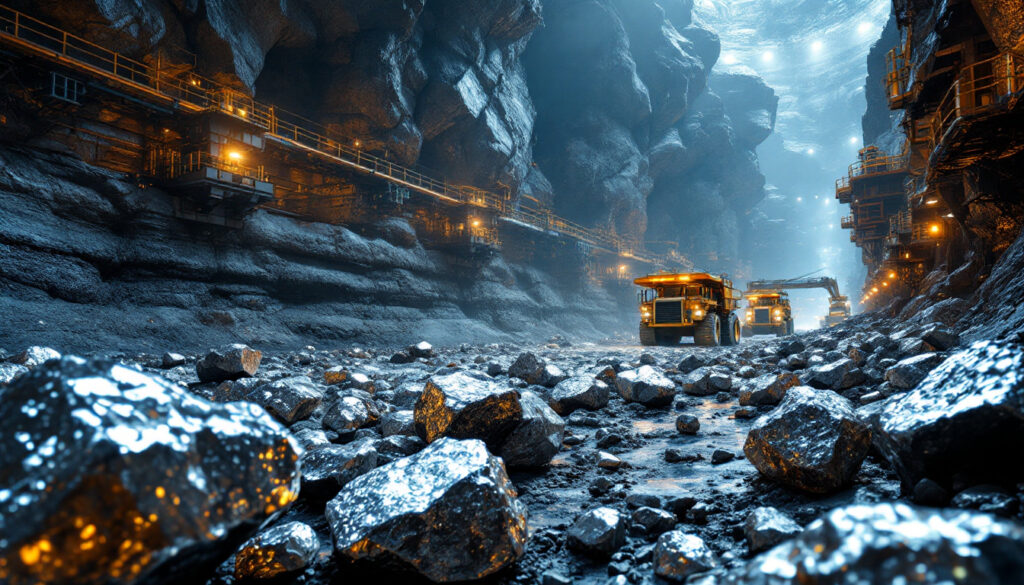What is the Flatreef Orebody and Why is it Significant?
The Flatreef orebody represents one of the world's most significant mineral discoveries, located on the Northern Limb of South Africa's Bushveld Complex. This remarkable resource has transformed from an exploration target to an operational mine through Ivanhoe Mines' decades-long development efforts, creating a new chapter in South African beneficiation history.
The Geological Marvel of Flatreef
The Flatreef orebody derives its name from its distinctive flat-lying, thick mineralization pattern—a stark contrast to the typically narrow, steeply-dipping reefs found elsewhere in the Bushveld Complex. At approximately 26 meters thick, this substantial ore zone enables more efficient bulk mining methods that significantly enhance extraction economics compared to traditional narrow-reef mining operations where thickness averages just 0.5-1 meters.
This exceptional thickness has allowed Ivanhoe Mines to implement large-scale mechanized mining techniques rarely possible in other Bushveld operations, dramatically improving both safety conditions and production efficiency.
Timeline of Discovery and Development
The journey from initial exploration to production at Flatreef spans more than three decades:
- Early 1990s: Ivanplats (Ivanhoe Mines subsidiary) secured initial exploration licenses
- 2010: Discovery of the Flatreef orebody
- 2022: Completion of shaft one production changeover
- May 7, 2025: First crews access the high-grade Flatreef orebody
- Q4 2025: Expected commercial production commencement
As Robert Friedland, founder and executive co-chairman of Ivanhoe Mines explained: "Platreef is the world-leading polymetallic mine in development… containing two billion tonnes of the world's richest platinum, palladium, rhodium, nickel, copper, and gold system."
How Does Platreef Compare to Other Global Mining Projects?
Exceptional Mineral Diversity and Scale
The Platreef mine stands apart from typical mining operations due to its polymetallic nature and extraordinary resource base:
- Diverse mineral portfolio: Contains platinum, palladium, rhodium, nickel, copper, and gold
- Massive resource: Exceeds 50 million ounces of gold-equivalent minerals
- Extended operational lifespan: 35-year mine life based on current indicated resources
- Expansion potential: Remains open in multiple directions with untapped opportunities
When compared to other global PGM projects like Sibanye-Stillwater's US operations or Russia's Norilsk Nickel facilities, Platreef's unique combination of mineral diversity, thickness, and grade creates a competitive advantage. Most competing PGM operations feature either narrower ore bodies or less diverse mineral assemblages, limiting their production flexibility.
Economic and Production Advantages
The unique characteristics of the Flatreef orebody translate to significant operational benefits:
- Cost efficiency: Positioned to become one of the world's lowest-cost PGM producers, potentially below $800/oz (compared to industry averages of $900-1,200/oz)
- Production scale: Expected to rank among the largest primary producers of platinum group metals globally
- Mining method optimization: The flat, thick nature of the deposit enables more efficient mechanized mining techniques
- Metal price resilience: Multiple revenue streams from diverse metals provide natural hedging against price volatility in any single commodity
Friedland has emphasized that Platreef is positioned to be the "lowest-cost… primary PGM producer" globally, a significant claim in an industry where production costs often determine survival during market downturns.
What Technical Developments Have Enabled Access to Flatreef?
Underground Infrastructure Progress
The underground mining engineering marvels at Platreef represent a significant achievement:
- Extensive tunnel network: 5.5km of underground tunnels completed across three levels
- Strategic access points: Development on the 750m, 850m, and 950m levels
- First ore extraction: Initial blast of high-grade ore occurred on May 7, 2025
- Surface stockpiling: Extracted ore will be stored before processing in the phase one concentrator
The tunneling process has required specialized equipment to navigate through the Bushveld Complex's notoriously hard pyroxenite rock formations, a challenge that has delayed many previous mining projects in the region.
Shaft Development and Hoisting Capacity
The mine's vertical infrastructure is equally impressive:
- Shaft one completion: Production changeover completed in May 2022
- Shaft two construction: In progress to become Africa's largest hoisting shaft
- Enhanced capacity: Will increase hoisting capability to more than 12 million tonnes per annum (mtpa)
Unlike many South African deep-level mines that rely on multiple narrow shafts, Platreef's design incorporates concrete-lined vertical shafts engineered for stability and efficiency at depth. These shafts comply with South African National Standards (SANS) for mining safety while enabling unprecedented ore movement capabilities for a PGM operation.
What is the Ownership Structure of the Platreef Project?
Strategic Partnership Model
The Platreef project operates under a multi-stakeholder ownership structure:
- Ivanhoe Mines: Holds a 64% indirect interest through subsidiary Ivanplats
- Japanese consortium: Led by ITOCHU and ITC Platinum Development with a 10% stake
- Broad-Based Black Economic Empowerment (B-BBEE): 26% interest allocated to comply with South Africa's mining regulations
This ownership model represents a carefully balanced combination of international mining expertise, foreign investment, and local empowerment priorities—critical for long-term operational stability in South Africa's evolving regulatory environment.
Regulatory Compliance and Social License
The ownership structure reflects both strategic business partnerships and compliance with South African mining legislation:
- Mining Right requirements: The B-BBEE component satisfies regulatory prerequisites under the Mining Charter
- International investment: The Japanese consortium represents significant foreign direct investment
- Operational control: Maintained by Ivanhoe Mines as the majority stakeholder
Unlike many mining projects that struggle with regulatory compliance, Platreef's 26% B-BBEE shareholding includes local community trusts, employee ownership schemes, and strategic Black entrepreneurs—creating a model that South Africa's Minerals Council has highlighted as exemplary for sustainable mining development.
What Makes the Bushveld Complex a World-Class Mineral Province?
Geological Significance
The Bushveld Complex, where Platreef is located, represents one of Earth's most extraordinary geological features:
- Massive igneous province: World's largest layered igneous intrusion
- Mineral endowment: Contains approximately 80% of global PGM reserves
- Structural divisions: Comprises Eastern, Western, and Northern Limbs
- Age: Formed approximately 2 billion years ago
Friedland has described the Bushveld as having a "globally significant precious metals endowment" unmatched anywhere else on Earth. The complex's unique formation history created ideal conditions for mineral exploration importance through magmatic differentiation processes.
Northern Limb Characteristics
The Platreef mine is specifically located on the Northern Limb, which offers distinct advantages:
- Broader mineralization: Typically features wider ore zones than other parts of the complex
- Different metal ratios: Often contains higher base metal content (copper and nickel)
- Exploration potential: Historically less developed than the Eastern and Western Limbs
The Northern Limb's geological characteristics differ significantly from the more extensively mined Eastern and Western Limbs. While the latter typically feature narrow, high-grade reefs, the Northern Limb hosts broader zones of mineralization with more consistent grade distribution—ideal for bulk mining methods.
"The Northern Limb represents a fundamentally different expression of the Bushveld's mineral potential," notes South Africa's Council for Geoscience in their regional mapping studies.
How Will Platreef's Development Progress Toward Commercial Production?
Phased Development Approach
The mine is implementing a strategic phased development plan:
- Current phase: Underground development and ore access
- Q4 2025: Target for commercial production commencement
- Future expansions: Planned phased growth to maximize production capacity
This methodical approach allows Ivanhoe Mines to manage capital expenditures while establishing early cash flow, a strategy that has proven successful at their Kamoa-Kakula copper operation in the Democratic Republic of Congo.
Processing Infrastructure
The mineral processing strategy includes:
- Phase one concentrator: Scheduled to begin processing ore in Q4 2025
- Surface stockpiling: Interim storage of extracted ore before processing
- Metallurgical optimization: Designed to handle the polymetallic nature of the ore
The processing facility will implement advanced flotation technology specifically calibrated for Platreef's unique ore characteristics. Based on preliminary metallurgical studies, recovery rates are expected to exceed 85% for platinum group metals and 90% for base metals—significantly higher than many competing operations.
Energy efficiency has been a key design consideration, with the processing plant incorporating variable speed drives, heat recovery systems, and potential renewable energy integration to minimize both costs and environmental impact.
What Impact Will Platreef Have on Global PGM Markets?
Supply Chain Significance
As Platreef moves toward production, its impact on global PGM markets could be substantial:
- Supply diversification: Adds a major new source to a concentrated producer landscape
- Cost curve influence: Potential to reset industry cost structures due to efficient operations
- Product mix: Will contribute significant quantities of platinum, palladium, rhodium, nickel, copper, and gold
Currently, over 70% of the world's palladium comes from Russia and South Africa, creating supply vulnerability. Platreef's entry will help reduce market concentration and enhance supply security for critical industrial metals.
Strategic Metal Production
The mine's output includes several metals critical to emerging technologies:
- Platinum and palladium: Essential for automotive catalytic converters and hydrogen fuel cells
- Nickel and copper: Key components for electric vehicle batteries and renewable energy infrastructure
- Rhodium: Critical catalyst with limited global production sources
The timing of Platreef's production coincides with accelerating demand for these metals, particularly in clean energy applications. Industry analysts at CRU Group have noted that new PGM supply is crucial as traditional internal combustion engines require increasing loadings of platinum and palladium to meet stricter emissions standards, while emerging hydrogen technologies create entirely new demand streams.
What Challenges Has the Project Overcome?
Development Hurdles
The 30-year journey from exploration to production has involved navigating numerous challenges:
- Technical complexity: Engineering solutions for accessing deep underground resources
- Market volatility: Adapting to fluctuating PGM prices over decades of development
- Regulatory environment: Complying with evolving South African mining legislation
- Infrastructure requirements: Developing power, water, and transportation capabilities
Unlike many mining projects that faced similar challenges and faltered, Ivanhoe Mines persisted through multiple commodity cycles and regulatory changes. For perspective, Anglo American Platinum's nearby Mogalakwena expansion faced similar challenges but progressed more rapidly due to its surface mining nature versus Platreef's underground complexity.
Market Skepticism
According to Robert Friedland, Ivanhoe Mines founder and executive co-chairman, the project faced doubts about its viability:
"Contrary to predictions that the Platreef Mine might not be built, the mine is now a reality… This colossal mine will grow in rapidly phased expansions, positioning the Platreef Mine as one of the lowest-cost, if not the lowest-cost, and largest primary producers of platinum group metals on our planet."
This skepticism stemmed partly from South Africa's challenging mining environment, which has seen declining investment in recent decades due to regulatory uncertainty, labor issues, and infrastructure limitations. Water use licensing alone delayed several major mining projects in the region by years.
FAQ: Understanding the Flatreef Development
What makes the Flatreef orebody different from other PGM deposits?
The Flatreef orebody is characterized by its unusual thickness (approximately 26 meters) and flat-lying orientation. Unlike the thin, steeply-dipping reefs typical in the Bushveld Complex, Flatreef's geometry enables more efficient bulk mining methods, potentially reducing costs and improving safety.
How long did it take from discovery to production at Flatreef?
The timeline spans approximately 15 years from the discovery of the Flatreef orebody to the first access by mining crews. However, the broader project timeline extends over 30 years from initial exploration licensing to projected commercial production.
What metals will be produced at the Platreef mine?
The Platreef mine will produce a diverse portfolio of metals including platinum, palladium, rhodium, nickel, copper, and gold. This polymetallic nature provides economic resilience against price fluctuations in any single commodity.
How does the Platreef project contribute to South Africa's mining sector?
The Platreef project represents significant foreign direct investment in South Africa's mining sector and includes substantial local ownership through its B-BBEE structure. The project will create employment, generate export revenue, and establish a long-life mining operation in a country with a rich mining industry evolution.
What environmental considerations are being addressed at Platreef?
Ivanhoe Mines has implemented water recycling systems, energy efficiency measures, and waste management protocols to minimize the environmental footprint of the Platreef operation. Unlike older Bushveld mines that struggle with acid mine drainage issues, Platreef's modern design incorporates environmental protection and mine reclamation innovation from the start.
Further Exploration:
Readers interested in learning more about South Africa's Bushveld Complex and its mineral potential can consult the South African Department of Mineral Resources and Energy's technical reports or Mining-Technology's in-depth profiles of major PGM projects. The Minerals Council South Africa also provides comprehensive resources on the economic impact of mining and B-BBEE compliance frameworks.
Interested in Discovering the Next Major Mining Breakthrough?
Discovery Alert's proprietary Discovery IQ model instantly notifies investors of significant mineral discoveries on the ASX, similar to the Flatreef orebody's transformative impact. Explore historic examples of exceptional returns from major discoveries at our dedicated discoveries page and gain the market-leading advantage you need for successful investment decisions.




